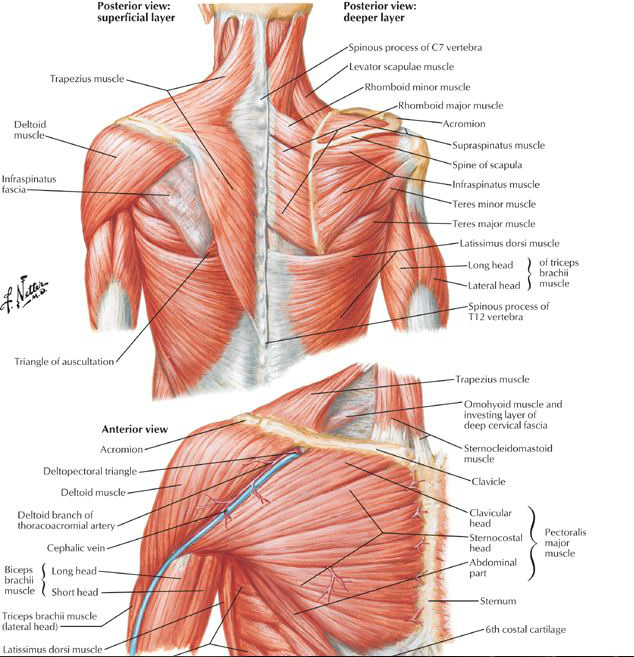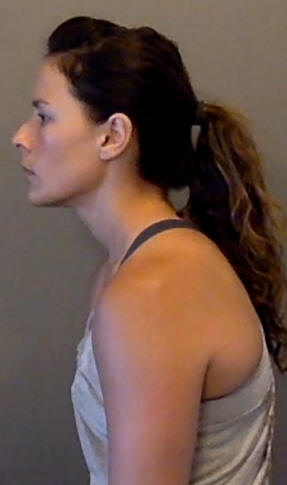Shoulder
 The
shoulder is in fact a complex that consists in three bones; the
humerus, the upper arm bone, the scapula, the shoulder blade, and
the clavicle, the collarbone. Those bones form three joints;
The
shoulder is in fact a complex that consists in three bones; the
humerus, the upper arm bone, the scapula, the shoulder blade, and
the clavicle, the collarbone. Those bones form three joints;
the glenohumeral joint (Shoulder Joint):
you’ll often hear it referred to as simply the shoulder joint. The
glenohumeral joint connects the upper arm bone to the shoulder blade. It
is a ball and socket joint. The head of the upper arm is shaped like a ball
which sits in a shallow socket at the lateral end of the shoulder blade;
the acromioclavicular joint: the acromioclavicular
joint connects the collarbone with the shoulder blade;

the sternoclavicular joint: the sternoclavicular
joint connects the collarbone with the breastbone;
the scapulothoracic joint: is not really a
joint. The shoulder blade sits on the back of the rib cage and moves up and down
and rotates with shoulder movement.
All three joints work together to allow movement of the arm in all directions.
We are treating the shoulder movments as if there was only one joint but note
that it is more complex than that.
By itself, the shoulder blade is not very mobile but unbalance in the muscles
stabilizing it will contribute to the overall lack of performance of the
shoulder. The movements of the shoulder other than the glenohumeral joint,
are depicted in the figure.
Flexion - Extension
Flexion: Bending the joint resulting in a decrease of angle; moving the
upper arm upward to the front. Typically accompanies Shoulder Girdle Elevation / Upward
Rotation.
Range of motion: 90-100°.
Extension:
Straightening the joint resulting in an increase of angle; moving the upper arm
down to the rear. Typically accompanies Shoulder Girdle Depression / Downward
Rotation.
Range
of motion: 40-60°.
Abduction - Adduction
Abduction:
Lateral movement away from the midline of the body; moving the upper arm up to
the side away from the body. Typically accompanies Shoulder
Girdle Upward Rotation. Range of motion: 90-95°
Adduction:
Medial movement toward the midline of the body; moving the upper arm down to the
side toward the body. Typically accompanies Shoulder
Girdle Downward Rotation. Range of motion: 75°.
Internal - External Rotation
Internal rotation: Rotary movement around the longitudinal axis of the
bone toward the center of the body; turning the upper arm inward. Typically
accompanies Shoulder
Girdle Protraction. Range of
motion: 70°.
External rotation: Rotary movement around the longitudinal axis
of the bone away from the center of the body; turning the upper arm outward.
Typically accompanies Shoulder
Girdle Retration. Range of motion: 90°.
Horizontal Abduction - Adduction
Horizontal abduction: Lateral movement away from the midline of
the body in a horizontal plane; moving the upper arm away from the chest with
the elbows facing down. Typically accompanies Shoulder
Retraction. Range of motion: 45°.
Horizontal adduction: Medial movement toward the midline of the
body in a horizontal plane; moving the upper arm toward and across the chest
with the back of the arm facing down. Typically accompanies Shoulder
Protraction. Range of motion: 135°.
Flexion: Deltoid, Pectoralis major (clavicular head),
Coracobrachialis, Biceps brachii (short head).
Extension: Latissimus dorsi, Deltoid (posterior), Pectoralis major
(sternal head), Teres major, Triceps brachii (long head).
Abduction: Deltoid (lateral), Deltoid (anterior), Suprospinatus,
Pectoralis major (clavicular head).
Adduction: Latissimus dorsi, Pectoralis mojor (sternal head),
Pectoralis major (clavicular head), Teres major, Coracobrachialis, Triceps
brachii (long head).
Horizontal abduction: Deltoid (posterior), Deltoid (lateral),
Infraspinatus, Teres minor.
Horizontal adduction: Pectoralis major (sternal head), Pectoralis
major (clavicular head), Coracobrachialis.

Mobility Evaluation:
Shoulder
Strength Evaluation:
Shoulder
Posture evaluation: might reveal a bad position of the shoulder and
shoulder girdle at rest.
FMS
: Shoulder Mobility,
this test gives an overall view of the shoulder mobility. The evaluation
of the mobility of specific movements is needed to pinpoint the problem.
Deep squat, can provide indication
of shoulder lack of mobility if the athlete is not able to put the stick
directly above his head.
Scapula Retraction
Constitutes a poor alignment of the shoulder at the scapula level. It
can influence performance in running and throwing by affecting the mobility and
strength of the shoulder.
Corrective measures
Strength:
Shoulder
Girdle Strength
Mobility:
YW Stretch
 The
shoulder is in fact a complex that consists in three bones; the
humerus, the upper arm bone, the scapula, the shoulder blade, and
the clavicle, the collarbone. Those bones form three joints;
The
shoulder is in fact a complex that consists in three bones; the
humerus, the upper arm bone, the scapula, the shoulder blade, and
the clavicle, the collarbone. Those bones form three joints; 





